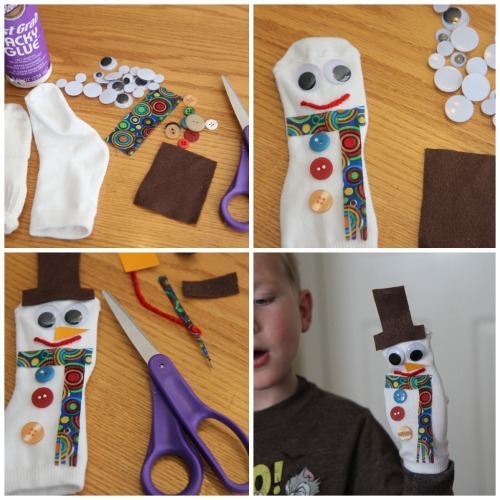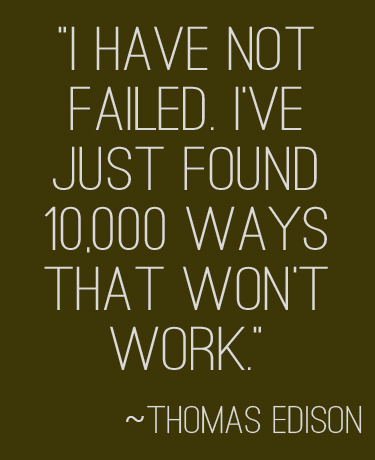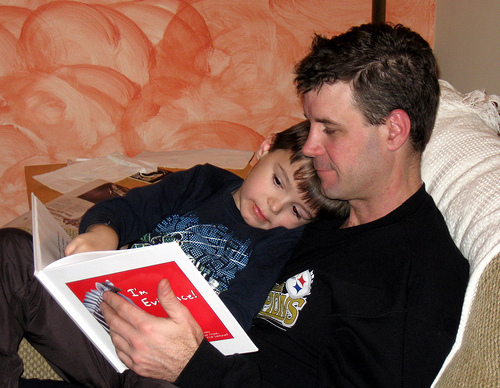Mandi Ehman's Blog, page 150
January 18, 2013
7 Things to Clean When Illness Strikes

The following post is from Becky of Clean Mama:

source: Steve A. Johnson
As soon as I have my cleaning routine implemented and running smoothly, all the laundry completed and drawers organized, it never fails someone gets sick. And then it spreads through the house and what do you know, it’s two weeks before things start getting back to normal. Getting sick is part of life and it’s good to build up healthy immune systems, but if there’s a slim chance that I can avoid it I’ll do what I can. I’ve found a couple things help stop the spreading when they’re done right away.
Mandi shared 5 ways to prevent the flu – these ideas can be added to that in your illness bag of tricks. I don’t do these things when someone has a little case of the sniffles – these are my tricks for influenza or stomach flu (both of which we’ve had this winter). I use natural and non-toxic cleaning supplies and eco-friendly microfiber cleaning cloths, but I do have a stash of non-toxic antibacterial cleaning wipes on hand for quick clean-ups and for times when someone’s sick. They work well on handles and switches, no drips from spray cleaner. I also use rubbing alcohol on a cotton ball or pad to clean phones, computer mouses, etc.
Clean all bathrooms. – Wipe down sinks and toilets – don’t forget to get the toilet handles and the door handles, light switch and switch plate.
Wash all hand towels. – Give everyone their own hand towel until sickness has passed.
Wipe down handles and handrails (refrigerator, dishwasher, stairs, sinks, etc.).
Wipe door handles. - Use a cleaning wipe to make this quick and easy.
Wipe light switches and switch plates. – I find that a non-toxic cleaning wipe best for this, no drips.
Wipe down phones, remotes, computer keyboards, electronic games and devices. - Wipe with a cotton pad dipped in rubbing alcohol.
Wash blankets and pillows that the family uses. – For us this means that I launder the pillows and blankets in our family room.
What would you add to the list?

Becky is a self-proclaimed clean freak and list maker. She is a work-at-home mom to three little ones, and in her spare time she enjoys sharing her cleaning and organizing tricks and tips on her blog, Clean Mama and through her Etsy Shop, Clean Mama Printables.
7 Things to Clean When Illness Strikes is a post from Life Your Way
© 2010-2013 Purple Martin Press, LLC | All rights reserved - This feed is provided for the convenience of Home Your Way subscribers. Any reproduction of the content within this feed is strictly prohibited. If you are reading this content elsewhere, please send an email to contact@yourway.net to let us know. Thanks.

Snowman Sock Puppet Craft

The following post is from Kristina of Toddler Approved:

source: Toddler Approved
January is always a month filled with setting goals and reorganizing at our house. Over the holidays we sorted through a lot of clothes and toys and ended up donating a lot of the ones we don’t use regularly. As I went through all of our baby clothes I found tons of socks! Many of them were single white socks with no matches, so I put them aside and decided that we would keep them to make sock puppets this year!
Sock puppets are amazingly simple to make using materials you already have at your house.
Since it is winter and we’ve been doing a lot of snowman crafts (while wishing for snow), we decided to make snowmen sock puppets!
Supplies:
socks
googly eyes
buttons
fabric
felt
yarn
tacky glue
scissors
cardstock or cardboard
sticks or small twigs (optional)

source: Toddler Approved
Directions:
To make these simple sock puppets, first cut out any shapes from the felt or fabric that you want to use as accessories (hats, scarves, etc.).
Next we used the tacky glue to start gluing buttons, googly eyes, yarn, cardboard, fabric, and felt onto the sock. I attempted to send my son outside on a twig hunt to find our snowmen some arms, but he was unsuccessful. I recommend that you add twigs to your snowmen or use toothpicks!
Once everything was glued on, we let the puppets dry and then we started playing with them!
My kids had fun re-enacting several of their favorite snowmen fingerplays and songs using the puppets, including Once there was a snowman and Frosty. We’ve also been reading several snowman books while we play with our puppets. No Time for Flashcards has a great list featuring several of our favorite snowmen books.

source: Toddler Approved
What else do you do with the extra socks you find around your house? Have you ever created something crafty with them?

Kristina is a mom of 2 and a former Special Ed teacher for children with communication disabilities. She blogs at Toddler Approved as she looks for ways to make life a little more fun and creative with her kids while embedding learning into everything that she does. Kristina tweets as @ToddlerApproved and can be found on FB and Pinterest.
Snowman Sock Puppet Craft is a post from Life Your Way
© 2010-2013 Purple Martin Press, LLC | All rights reserved - This feed is provided for the convenience of Family Your Way subscribers. Any reproduction of the content within this feed is strictly prohibited. If you are reading this content elsewhere, please send an email to contact@yourway.net to let us know. Thanks.

Embrace Failure {31 Days to Your Goal}


If you’re just joining us, be sure to start at the beginning of the 31 Days to Your Goal series!
Yesterday, my goal-setting advice was summed up in two words: expect success. Today — because I like to keep you on your toes — I’m going to offer you what may appear to be the opposite advice: embrace failure.
When I said to expect success, I meant it. You have to believe that you can and will achieve your goal for there to be any hope of actually doing it. But what I didn’t mean is that you should expect perfection.
We’ve talked about perfection paralysis a little bit already too. And you know the cure is for perfection paralysis? Expecting imperfection. Embracing the failure.
Embracing the failure means learning from your each failure and looking at it as a stepping stone to success rather than a burden that’s weighing you down. It means acknowledging that each time you fail brings you one step closer to success…but only if you continue trying.
When you embrace failure, it’s no longer something to fear, something that holds you back from trying. Being willing to fail means you’re much more likely to succeed!
How has failure made you better? What have you learned about yourself or a goal through failure?

Mandi Ehman is the founder and publisher behind Life Your Way and the co-author of All in Good Time, as well as a wife and the homeschooling mom to four beautiful girls. She lives with her family on a little slice of heaven in wild, wonderful West Virginia and loves coffee, chocolate, easy meals, beautiful things and minimalist spaces.
Embrace Failure {31 Days to Your Goal} is a post from Life Your Way
© 2010-2013 Purple Martin Press, LLC | All rights reserved - This feed is provided for the convenience of Work Your Way subscribers. Any reproduction of the content within this feed is strictly prohibited. If you are reading this content elsewhere, please send an email to contact@yourway.net to let us know. Thanks.

January 17, 2013
3 Simple Words to Revitalize Your Work Style in 2013

The following post is from Michelle of Mommy Misadventures :

source: freedigitalphotos.net
As we kick off the year, here are three words to consider adding to your vocabulary — or using a little more regularly — in 2013:
“Hello.”
For lots of work at home professionals, isolation can be a challenge. Online communication like e-mail, IM and voice chat help keep us all in touch while online groups like mailing lists and boards and chatter via Facebook and Twitter take the place of standard office water cooler talk.
But despite these technological advances, nothing beats the energy and excitement you get from meeting in person. When I worked in an office, I must have said “hello” or “good morning” to at least ten people before I had even reached my chair. Contrast that to working at home where, if not for my family being at home with me, I could probably go an entire week without saying “hello” aloud to anyone aside from my family.
There’s just an intangible energy you get from really connecting with your clients and colleagues in a real world setting. I’m making it a goal this year not only to meet more new people in person through things like professional mixers and blogger events but also keep in touch with my local clients and colleagues over a cup of coffee whenever possible.
“No.”
Last year, I was in the habit of saying “yes” to whatever work came my way. “More work is the sign of a success!” I thought; if more work was coming in, I must be doing well. After a few months of this, I was making (marginally) more money, but I was unhappy. I had taken on too much, too quickly, doing work that I was capable of doing but wasn’t passionate about. I’m not proud to admit that the quality of my work at the time was not great. When a project I was more interested did come up, I was already tied up or too busy to accept it. More importantly, the workload was taking a toll on my family life. Not cool.
I learned a valuable lesson: Just because I can accept a project doesn’t necessarily mean I should. So this year, I reassessed my work priorities. I drew up a list about what was important to me and I’m determined to work on projects that align with this list. That sometimes that means saying “no” to projects that I would have accepted a year ago.
On the upside, while I may turn down a project for myself, I can turn it around into opportunity for someone else. Saying “no” to projects means I recommend other people in my circles for projects that align better with their specialties.
“Help.”
When a plea for help circulates in my networking circles, I’m more than happy to volunteer my services. But being on the other side of that equation, well, that’s a new one for me. For too long, I’ve allowed myself to toil through projects that I could really use some help on but without reaching out to my support network.
Establishing my priorities this year had a great side effect: it helped me accept my limitations. By accepting these limitations — and accepting that no one has to do everything on their own — I am able to recognize when I need help. And it’s good to ask for help. you don’t ask, no one will know that you need it. Reaching out to ask for help not only lightens the workload but also helps create and reinforce new work connections and collaborations.
What words can you think of to help change up YOUR work style this year?

Michelle Mista is an IT professional, writer and blogger with a love for all kinds of technology. She writes about tech tips and trends for work at home professionals on her portfolio blog and muses about motherhood at Mommy Misadventures. She is on the constant quest to balance life, work and geekery.
3 Simple Words to Revitalize Your Work Style in 2013 is a post from Life Your Way
© 2010-2013 Purple Martin Press, LLC | All rights reserved - This feed is provided for the convenience of Work Your Way subscribers. Any reproduction of the content within this feed is strictly prohibited. If you are reading this content elsewhere, please send an email to contact@yourway.net to let us know. Thanks.

Four Ways to Get Dad More Involved in Homeschooling

The following post is from Angie of Many Little Blessings:

source: don.wing45
One of the jokes at my husband’s work is when his coworkers ask him what a parent-teacher conference looks like in our family. While this was initially amusing, it really made me realize that those jokes came out of an assumption that his co-workers believed that separated my husband from our homeschooling.
Instead of seeing my husband as an active member of our homeschool, it was assumed that he had more of a role that was on the periphery of our homeschooling. And then it hit me then that it might not have been far from accurate. I was the one planning the curriculum, creating plans, and carrying out the teaching. He was left only the opportunity to ask what the kids had learned that day as casual dinner conversation.
I decided that it was important for me, for him, and for our children to make sure that he was a more active member of our homeschooling, at least as much as his work permitted. If you have been feeling like I felt, then you might use some of these ideas that we’ve tried to help my husband be more involved in our homeschooling.
Have him teach one subject.
A great way to help involve Dad in homeschooling is to have him responsible for teaching one school subject, if that is something he would be interested in. This might mean that he plans and teaches a subject or that he teaches from already prepared lesson plans.
If it seems like too much to teach one entire subject, there might be just portions of a subject that he could tackle. In our house, I have very little patience for intricate science experiments. Because of this, it’s not uncommon for me to ask my husband to set up and complete the experiment with the children. This works for us because it is already an area that he enjoys and he has more patience for detailed instructions than I do.
Plan special hands on projects.
Another thing that we’ve tried at our house that has been met with a lot of enthusiasm was to have my husband work on specific, short term hands on projects with the children, typically on a one-0n-one basis. One source of those types of projects for us has been through 4-H. Thanks to those 4-H projects, the children have each been able to have very special hands-on instruction from my husband in areas that are outside of my expertise, such as woodworking and electrical projects.
Schedule solo excursions or field trips.
It can be fun for Dad and kids when they go on a field trip or educational excursion without Mom. If Dad is a nature lover, this might mean hikes for a nature study. If Dad loves history, it might mean a trip to a historical society or history museum.
One of the things that my husband and children love to do together is visit the library and then out for a small ice cream. This is something they do once every week or two, and it’s a special time for them to find books to read during school and for pleasure. (It also gives me a chance to have some time alone at home.)
Assist with curriculum choices.
I was shocked when I asked my husband to help me make a science curriculum choice and he actually got excited. He admitted that while he hadn’t thought he would have wanted to help, he actually enjoyed researching options with me to make a decision together. After that, I decided to consult with him about many of our curriculum choices, and he was happy to be involved each time. Even though he works full time, he felt like this gave him a real say in what we were doing at home.
What are some ways that you have worked to get Dad involved in your family’s homeschooling?

Angie, a domestically-challenged writer and artist, is a homeschooling mom to three children. She writes about everything that happens in their lives between all the loads of laundry at Many Little Blessings. She is also the founder of The Homeschool Classroom, Catholic Mothers Online, and Just a Tiny Owl.
Four Ways to Get Dad More Involved in Homeschooling is a post from Life Your Way
© 2010-2013 Purple Martin Press, LLC | All rights reserved - This feed is provided for the convenience of Family Your Way subscribers. Any reproduction of the content within this feed is strictly prohibited. If you are reading this content elsewhere, please send an email to contact@yourway.net to let us know. Thanks.




